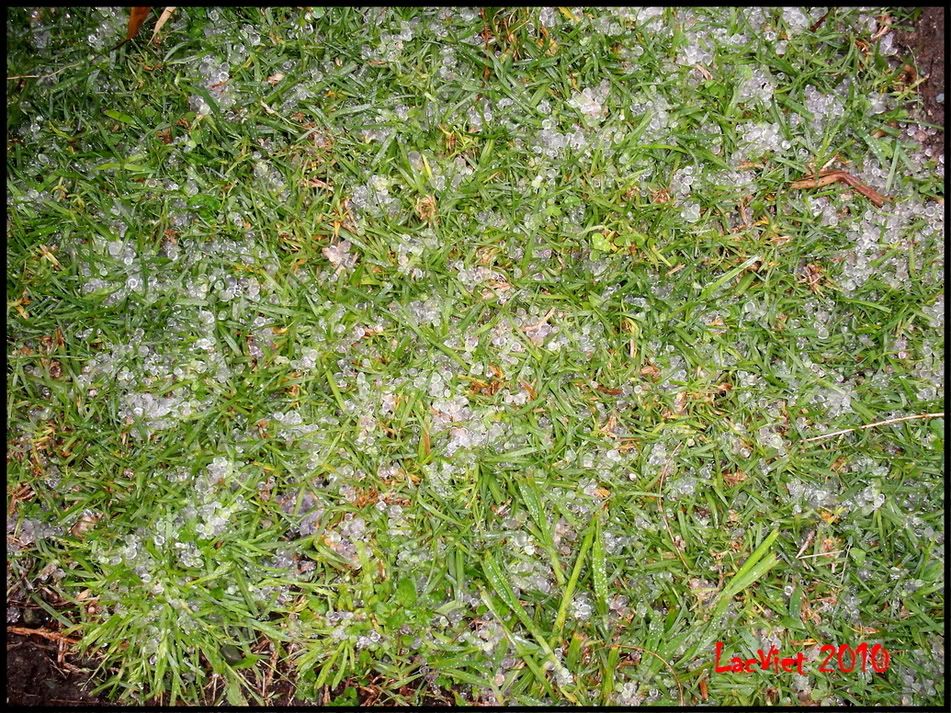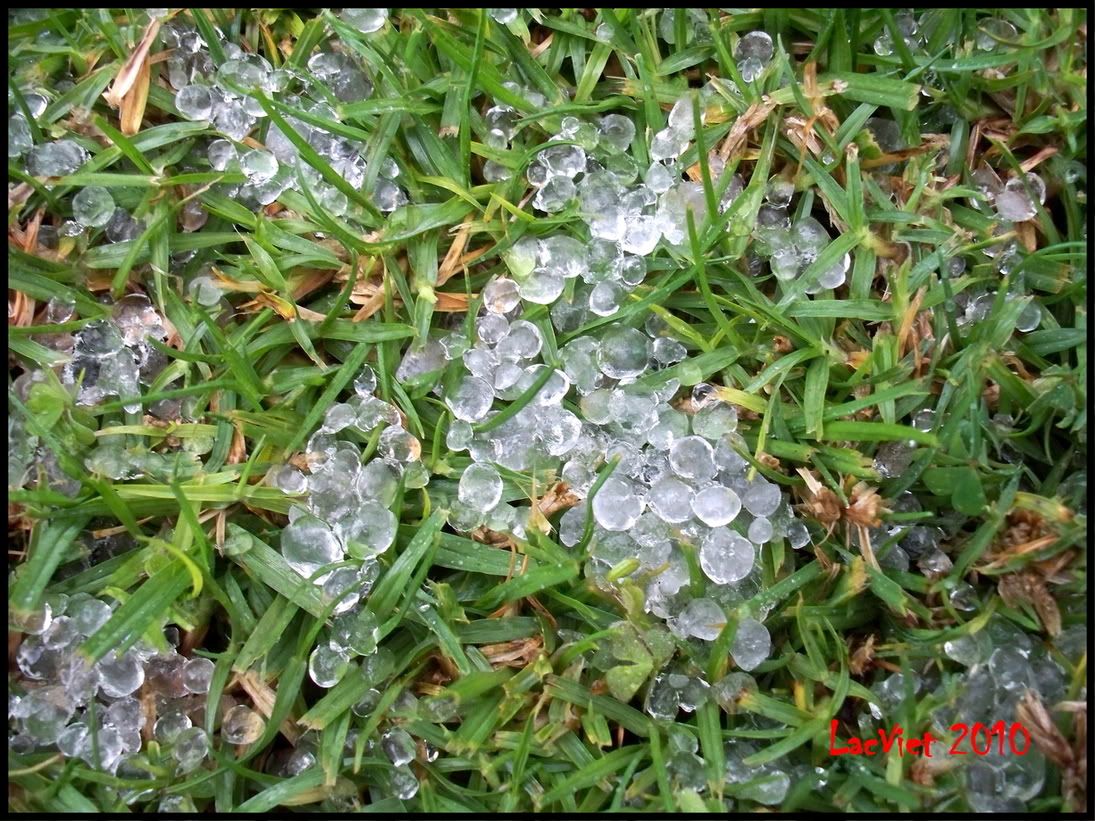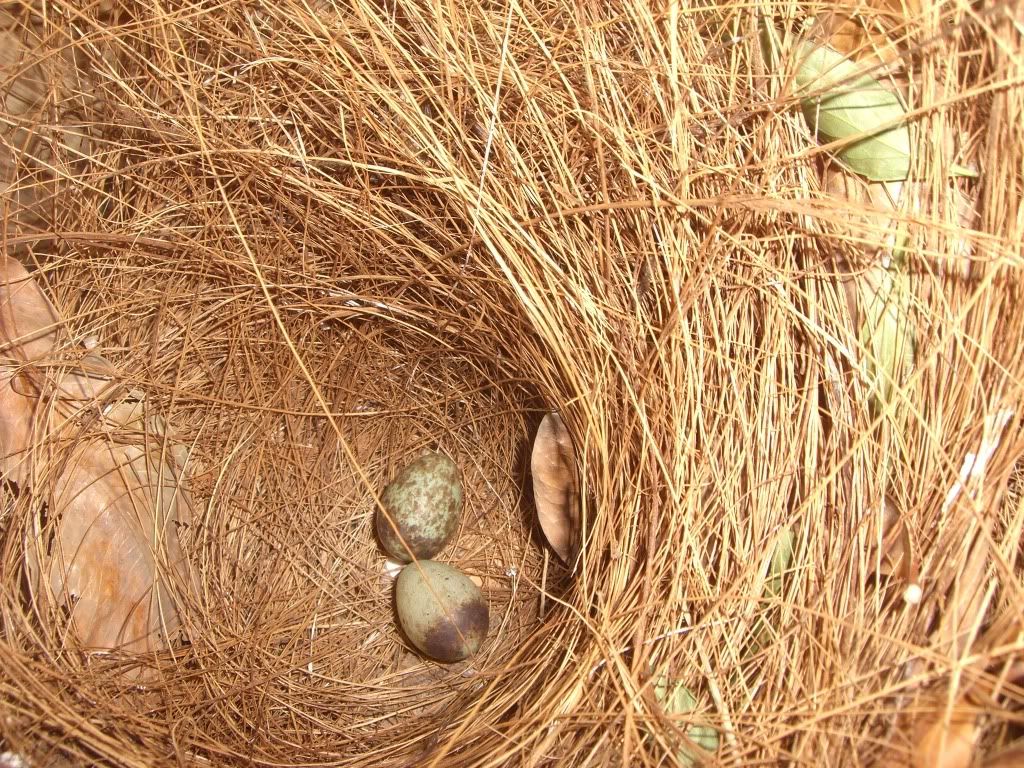
This blog is a repository of information on the White-rumped Shama (Copsychus malabaricus) including breeding information, and other songbirds/pets that I keep from time to time. I can be contacted at lacvietcrct@gmail.com.
Saturday, February 27, 2010
What a crazy day today: Windy, Rainy, Hail, and Rainbow!
The weather here lately is not co-operate with breeding white-rumped shama project. This year is one of the most rain fall in a very long time. There are also lots of strong wind blowing this rainy season. Today we have strong wind up to 25mph early in the morning, rain with showers/thunderstorms almost whole day, and HAIL! We haven't see hail for a very long time, probably at least 10 years since the last one. So far the first introduced pair is fine but no sign of breeding yet (building nest, lay eggs). The second introduced pair (H32N1 and H5N1) is staying together with no chasing around from the male. Again, still no sign of breeding yet. As for the pair that I really want to breed (H4N1 and H1N1), the male is ready to breed but the female seems not. She is too scare of him everytime he flies near her. I can see that he did not try to fight, bite, or doing in aggressive nature but she is still very nervous and would fly all over the aviary trying to hide from him. I'll try to introduce this pair again in another week or when the temperature is warmer with lots of sunshine.


First Eggs of the 2010 Season from my friend OrangeHorn
Looks like my friend Tung Tran is one of the first few person on this side of the world has white-rumped shama eggs in this 2010 season :) Congrats my friend!
First egg laid on 02/25/2010 which is very early in the season and is the result of careful planning and careful control of temperature, daylight, and diets.
You can view his blog at: http://tungthtran.blogspot.com/
First egg laid on 02/25/2010 which is very early in the season and is the result of careful planning and careful control of temperature, daylight, and diets.
You can view his blog at: http://tungthtran.blogspot.com/
Update on 03/10/2010: One egg lost few days after laid. One egg hatch after 11 days of incubation:
Monday, February 22, 2010
Winter time and available of live food source
Winter time is a time that live food is scarce and hard to find one in large quantity. It is always hit hard for hobbyists who keep insect eating animals such as lizards and insectivore bird right about after mid-winter passed, near spring time. This is the time that most feeder insect (such as crickets, mealworms, waxworms,etc.) farm did not have enough supply to sell. One of the reason is because of insect in generals need great deal amount of warm to be able to grow and breed, and winter time cause them to slow growth and slow down the breeding cycle. Another reason is that winter is also a time of rain, and with the low temperature and high humidity combined, this combination can cause disease in insect's colony and kill them off in large quantity. Winter storm in certain area can hinder the shipping of those crickets across country. Since the farms produce less quantity of feeder insect they either they raise the price up which none of the farms want to do, keep the same price but sell less quantity than what suppose to be (which they usually do), or they sell in very limited quantity per customer. Some farm might have to shut down for few weeks because they didn't have enough to sell. In addition, the farm also charges higher shipping cost due to they have to add head pack to keep the crickets alive or we must pay premium shipping cost (usual 2 day guarantee delivery) so that the crickets can be sure still alive when arrived at our home. This is happens to few of us last week as the farm we usual buy did not have any crickets to sell due to some kind of disease cause most of the farm's cricket to die. Because we usually buy enough supply for two week at a time, so most of us did not have crickets to feed our birds for two weeks. Luckily, I have back up source to buy crickets with reasonable price, mealworms as addition live food source, and still have few thousands of B. lateralis in the garage so I have no issue. With about a dozen of insect eating birds, few days of no live food is ok, but few weeks of no live food is devastating to the birds. Because the demand of live insects is so large in the U.S and there are several of insect farms across the country, there is rarely a time that we as a hobbyist could not buy those insects such as cricket in this hard winter time but we might have to pay more than usual due to shipping cost of extra heat pack. So having back up source of live food to buy, feed the bird additional live food source, and/or raising few of the live food source yourself can guarantee that the birds have constant supply of live food to eat and more importantly, no extra money to spend! :)
Saturday, February 20, 2010
Initial Introduction of the White-rumped Shama pair
Just about the same time last year, on 02/17/2010 I start to introduce the last year breeding pair together. I hang the bamboo cage with the male H3N1 inside in front of the female's aviary (H2N1) so they can both see each other. I also remove the middle plywood to combine both small aviary to one big one (4ft x 4ft x 6ft) and put the nest in (two nest total for them to choose). On 02/19/2010, I open the bamboo cage to allow the male to able to go into the aviary with the female. Both birds are kept in separate aviary since last year but right next to each other so they get use to the sound of his/her neighbor and since they are mate pair last year, it's a breeze to re-introduce them this year. The male sings very soft, low song. Few minutes after open the bamboo cage's door, the female enters the bamboo cage to stand side by side with her mate. About half hour later, the male starts courting the female and choose the nest.
Here are some of the video clip that I recorded.
Here are some of the video clip that I recorded.
Wednesday, February 17, 2010
Link to video clip of breeding Hwamei
Little over a week ago, one of my friend Dungdavang2000 send to me a link of someone breeding Hwamei via ShoutMix. Because ShoutMix has limited posted, I want to post the link here so everyone can enjoys and possible learn a few tips/ technique so that one day we can successful breeding this bird.
http://v.youku.com/v_show/id_XMTIzMjA0MzQ0.html
http://player.youku.com/player.php/sid/XMTIzMjA0MzQ0/v.swf
http://v.youku.com/v_show/id_XMTIzMjA0MzQ0.html
http://player.youku.com/player.php/sid/XMTIzMjA0MzQ0/v.swf
Saturday, February 13, 2010
Happy Vietnamese/Chinese New Year and Happy Valentine Day!
May this Tiger year bring you and your family full of Happiness, Wealth, Prosperity, and Health.
Wednesday, February 10, 2010
Troupial pics
Few days has pass, he eats mostly insects (loves mealworms) and few fruits. Has not eat much pellets at all. He also loves to drink nectar water that made for Oriole (similar to Hummingbird nectar but instead of red color, it's orange color). He calls a few note but it doesn't match with any sound that I hear from youtube or online.
Friday, February 5, 2010
Troupial - Icterus icterus
Troupial - Icterus icterus is a Venezuelan bird that belongs to "New World Orioles." It has nice song and exhibits beautiful plumage color. If you search on youtube, there are quite a few clips that hand tame troupial performs its song and dance. Some can learn to whistle a song! Compare to shama thrush's song, I guess Troupial didn't have lots of variety in a song but Troupial's song sounds is unique and more like flute like sound.
I have eye on this bird for a while until now. This is my newest addition to the flock, and I'm very excited to have this bird. According to the owner, this Troupial is about a year old and dna test as a male. He looks very healthy, jumping/flying around the aviary; however when I put him in the bamboo cage, I surprise that he is very calm and alert; still little nervous but not jumping around wildly. Few hours after I left him alone in the bamboo cage, I offer him few roaches and he starts to eat right away but I have to stand back few feet away before he jumps down to eat. After eating few insects, I be able to stick my camera right at the cage to take these two pictures below. Because of the low light condition and I didn't want to turn the flash on that close to the cage, the color is not 100% accurate but pretty close to actual. I'll take some more pics in daylight and update his progress as often as I could.
I have eye on this bird for a while until now. This is my newest addition to the flock, and I'm very excited to have this bird. According to the owner, this Troupial is about a year old and dna test as a male. He looks very healthy, jumping/flying around the aviary; however when I put him in the bamboo cage, I surprise that he is very calm and alert; still little nervous but not jumping around wildly. Few hours after I left him alone in the bamboo cage, I offer him few roaches and he starts to eat right away but I have to stand back few feet away before he jumps down to eat. After eating few insects, I be able to stick my camera right at the cage to take these two pictures below. Because of the low light condition and I didn't want to turn the flash on that close to the cage, the color is not 100% accurate but pretty close to actual. I'll take some more pics in daylight and update his progress as often as I could.
Wednesday, February 3, 2010
Tuesday, February 2, 2010
Breeding white-rumped shama: Using high tech
Tung Tran, who is my friend who familiar with high tech stuffs and just begin into keeping/breeding shama set up this live webcam so that he and all his friends can view the shama pair that he attempts to breed this year. This is the first time he breeds songbirds so there is always nervousness when introduce the male and the female together for the first time. After 3 days of introduction, so far so good with the male occasional chases the female, but nothing serious.
You can view the live webcam of Tung Tran's shama pair on the column on the left, right after my profile or click on this link: http://orangehorn.camstreams.com/
Good luck with the pair and keep us update, bud!
You can view the live webcam of Tung Tran's shama pair on the column on the left, right after my profile or click on this link: http://orangehorn.camstreams.com/
Good luck with the pair and keep us update, bud!
Subscribe to:
Posts (Atom)














